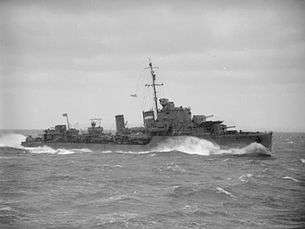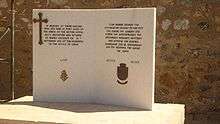HMS Intrepid (D10)
 | |
| History | |
|---|---|
| Name: | HMS Intrepid |
| Builder: | J. Samuel White, Cowes, Isle of Wight |
| Laid down: | 13 January 1936 |
| Launched: | 17 December 1936 |
| Identification: | Pennant number: D10 |
| Fate: | Sunk by air attack, 27 September 1943 |
| General characteristics (as built) | |
| Class and type: | I-class destroyer |
| Displacement: | |
| Length: | 323 ft (98.5 m) |
| Beam: | 33 ft (10.1 m) |
| Draught: | 12 ft 6 in (3.8 m) |
| Installed power: |
|
| Propulsion: | 2 shafts, 2 geared steam turbines |
| Speed: | 35.5 knots (65.7 km/h; 40.9 mph) |
| Range: | 5,500 nmi (10,200 km; 6,300 mi) at 15 knots (28 km/h; 17 mph) |
| Complement: | 145 |
| Sensors and processing systems: | ASDIC |
| Armament: |
|
HMS Intrepid was one of nine I-class destroyers built for the Royal Navy during the 1930s.
Description
The I-class ships were improved versions of the preceding H-class. They displaced 1,370 long tons (1,390 t) at standard load and 1,888 long tons (1,918 t) at deep load. The ships had an overall length of 323 feet (98.5 m), a beam of 33 feet (10.1 m) and a draught of 12 feet 6 inches (3.8 m). They were powered by two Parsons geared steam turbines, each driving one propeller shaft, using steam provided by three Admiralty three-drum boilers. The turbines developed a total of 34,000 shaft horsepower (25,000 kW) and gave a maximum speed of 35.5 knots (65.7 km/h; 40.9 mph). Intrepid carried a maximum of 455 long tons (462 t) of fuel oil that gave her a range of 5,500 nautical miles (10,200 km; 6,300 mi) at 15 knots (28 km/h; 17 mph). The ships' complement was 145 officers and ratings.[1]
The ships mounted four 4.7-inch (120 mm) Mark IX guns in single mounts. For anti-aircraft (AA) defence, they had two quadruple Mark I mounts for the 0.5 inch Vickers Mark III machine gun. The I class was fitted with two above-water quintuple torpedo tube mounts for 21-inch (533 mm) torpedoes.[2] One depth charge rack and two throwers were fitted; 16 depth charges were originally carried,[1] but this increased to 35 shortly after the war began.[3]
Construction and career
In the Second World War, Intrepid attacked and sank the German submarine U-45 south-west of Ireland on 14 October 1939 in company with the destroyers Ivanhoe and Inglefield. She participated in the pursuit and destruction of the German battleship Bismarck in May 1941, and in Operation Pedestal, the escorting of a convoy to Malta in August 1942.
Intrepid was adopted by the town of Uxbridge in 1942 to raise funds for the ship's costs.[4]
Sinking

Intrepid was attacked by German Ju 88 aircraft and sunk in Leros harbour in the Aegean Sea on 26 September 1943. This was the second ship lost under the command of Commander Charles de Winton Kitcat during the war. Kitcat was in command of Imperial when she was lost while evacuating troops from Crete in 1941.
Notes
References
- Crabb, Brian James (2014). Operation Pedestal. The Story of Convoy WS21S in August 1942. Donington, Lincolnshire, UK: Shaun Tyas. ISBN 978-1-907730-19-1.
- English, John (1993). Amazon to Ivanhoe: British Standard Destroyers of the 1930s. Kendal, England: World Ship Society. ISBN 0-905617-64-9.
- Friedman, Norman (2009). British Destroyers From Earliest Days to the Second World War. Annapolis, Maryland: Naval Institute Press. ISBN 978-1-59114-081-8.
- Haarr, Geirr H. (2010). The Battle for Norway: April–June 1940. Annapolis, MD: Naval Institute Press. ISBN 978-1-59114-051-1.
- Haarr, Geirr H. (2009). The German Invasion of Norway, April 1940. Annapolis, Maryland: Naval Institute Press. ISBN 978-1-59114-310-9.
- Lenton, H. T. (1998). British & Empire Warships of the Second World War. Annapolis, Maryland: Naval Institute Press. ISBN 1-55750-048-7.
- Rohwer, Jürgen (2005). Chronology of the War at Sea 1939-1945: The Naval History of World War Two (Third Revised ed.). Annapolis, Maryland: Naval Institute Press. ISBN 1-59114-119-2.
- Whitley, M. J. (1988). Destroyers of World War Two: An International Encyclopedia. Annapolis, Maryland: Naval Institute Press. ISBN 0-87021-326-1.
- Winser, John de D. (1999). B.E.F. Ships Before, At and After Dunkirk. Gravesend, Kent: World Ship Society. ISBN 0-905617-91-6.
Coordinates: 37°7′N 26°51′E / 37.117°N 26.850°E